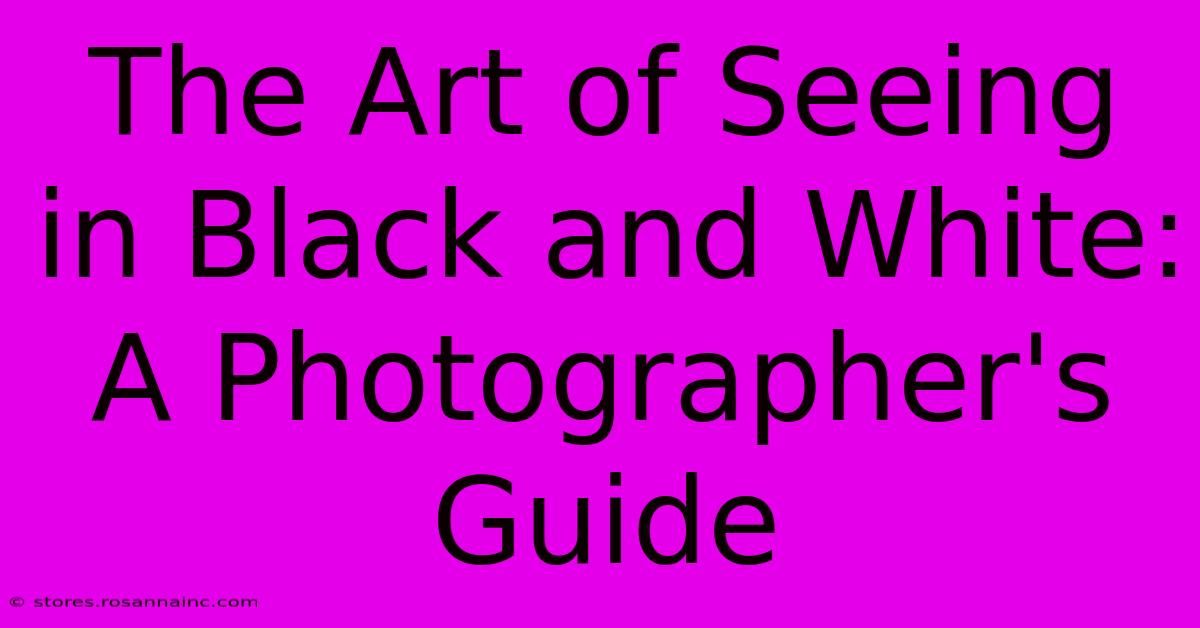The Art Of Seeing In Black And White: A Photographer's Guide

Table of Contents
The Art of Seeing in Black and White: A Photographer's Guide
Black and white photography. It's a timeless art form, stripping away the distractions of color to reveal the essence of a scene. But it's more than just removing color; it's about seeing differently, about understanding light, shadow, texture, and form in a whole new way. This guide will delve into the techniques and artistic considerations that will elevate your black and white photography.
Understanding the Fundamentals: Light and Shadow
The cornerstone of compelling black and white photography is a masterful understanding of light and shadow. Color serves as a distraction; in monochrome, light and shadow become your primary tools for conveying mood, depth, and emotion.
Mastering Light:
- High-Key Lighting: This style emphasizes bright tones, creating a feeling of lightness and airiness. Think ethereal portraits or landscapes bathed in soft sunlight.
- Low-Key Lighting: This dramatic approach uses deep shadows and strong contrasts, often conveying mystery, drama, or a sense of foreboding. Think gritty street photography or evocative portraits.
- Directional Lighting: Careful consideration of the direction of your light source is crucial. Side lighting accentuates texture, while backlighting creates silhouettes and highlights. Front lighting can flatten the image, so use it sparingly.
Harnessing Shadow:
- Shadow as Shape: Shadows aren't just the absence of light; they're shapes that contribute to the overall composition. Learn to see how shadows interact with the subject and the surrounding environment.
- Depth Through Shadow: Shadows create depth and dimension in your images. They define form, separate elements, and lead the viewer's eye.
- Mood Through Shadow: The mood of your photograph is heavily influenced by the interplay of light and shadow. Dark, brooding shadows can create a sense of mystery, while soft, diffused shadows can create a feeling of serenity.
Beyond the Basics: Composition and Technique
Strong composition is paramount in black and white photography. Without the distraction of color, every element must contribute to the overall impact of the image.
Compositional Techniques:
- Rule of Thirds: This classic guideline helps create visually balanced and engaging compositions.
- Leading Lines: Use lines to draw the viewer's eye through the image, creating a sense of depth and movement.
- Negative Space: Embrace empty space to emphasize your subject and create a sense of calm or isolation.
- Symmetry and Patterns: Repeating elements and symmetrical compositions can create strong visual impact.
Technical Considerations:
- Choosing Your Camera: While any camera can shoot black and white, some cameras offer superior control over image settings.
- Shooting in RAW: Shooting in RAW format gives you the greatest flexibility in post-processing, allowing you to fine-tune your images.
- Post-Processing Techniques: Software like Adobe Lightroom and Photoshop allows for precise control over contrast, tone, and detail. Explore techniques like dodging and burning to further enhance your images.
The Artistic Vision: Finding Your Style
Black and white photography is a journey of self-discovery. Experiment, explore different subjects, and develop your unique artistic voice.
Finding Inspiration:
- Study the Masters: Look at the work of renowned black and white photographers for inspiration. Analyze their compositions, lighting, and use of shadow.
- Explore Different Genres: Try different genres, from portraiture to landscape, street photography to abstract images.
- Experiment with Film: Consider shooting film for a unique aesthetic and a more tactile experience.
Developing Your Style:
- Focus on a Specific Subject: Developing expertise in a particular area, such as architectural photography or nature photography, can help solidify your style.
- Embrace Your Personal Vision: Don't be afraid to break the rules and experiment with different techniques to create a style that's uniquely yours.
- Consistent Post-Processing: Develop a consistent post-processing workflow to ensure your images have a unified look and feel.
Mastering the art of black and white photography is a continuous process of learning, experimenting, and refining your vision. By understanding the fundamentals of light and shadow, employing strong compositional techniques, and developing your unique style, you'll be well on your way to creating stunning and evocative monochrome images.

Thank you for visiting our website wich cover about The Art Of Seeing In Black And White: A Photographer's Guide. We hope the information provided has been useful to you. Feel free to contact us if you have any questions or need further assistance. See you next time and dont miss to bookmark.
Featured Posts
-
Uncover The Secrets Behind Eli Lillys Iconic Logo A Journey Through History
Feb 06, 2025
-
Sip On Sophistication The Rich And Velvety Charm Of Cherry Mocha Nail Enamel
Feb 06, 2025
-
Unveiling The Secret Shield How Polyurea Protects Embassies From Blasts
Feb 06, 2025
-
A Crossroads Of Alphabet Magic Discover The Hidden Power Of X Bar Letters
Feb 06, 2025
-
Glitter Galaxy Overload How Dnd Gel Polish Transforms Nails Into Celestial Wonders
Feb 06, 2025
